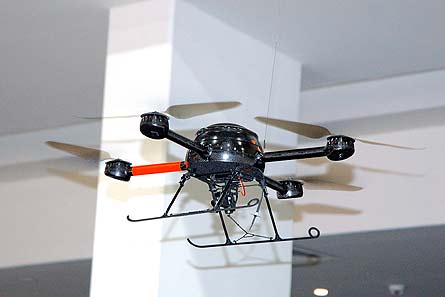German-headquartered SIM Security and Electronic System says it has sold an undisclosed number of its Sky-Eye quadrotor UAVs into China for use by a civilian police organisation.
SIM also says it is examining a scaled up version of the electrically powered UAV to pursue emerging opportunities in the global law-enforcement sector.
Total sales of the existing system, including the Chinese orders, have exceeded 30 units according to Yves Degroote, Brussels account manager for the firm. Speaking to Flight Unmanned at last week’s IDEX 2007 exhibition in Abu Dhabi he said other firm customers were located in Belgium, Bulgaria, and the Netherlands.
The Chinese sale occurred “recently” Degroote says, but he declines to provide further details.
Sim is currently working on an eight week turnaround on orders for standard configuration systems Degroote said.

Sky-Eye in flight inside the IDEX 2007 exhibition halls
Sky-Eye is near identical to the Diehl BGT Defence SensoCopter system, with both craft based on an underlying design from a still to be identified German partner company. Diehl is authorised to pursue the military market while SIM is restricted to commercial sales.
Diehl unveiled a fully autonomous version at the May 2006 Berlin Air Show with this incorporating a hybrid navigation suite incorporating both GPS and INS system. First flights of that version occurred in late 2005 and the system last year participated in funded German Army mini-vertical-take-off and landing (VTOL) UAV trials.
The SIM variant is only available in a remotely operated configuration with indoor demonstrations flights being carried out inside the IDEX exhibition halls for the duration of the show.
Both versions of the UAV feature the same moulded carbon fibre airframe and have a maximum take-off weight of 1.1kg. The UAV itself weighs 900g, allowing 200g for payloads. Both versions have 20min endurance and an effective operational radius of some 500m.
The original SensoCopter design featured four half-loop carbon struts stretched between each rotor head and the central battery and sensor housing to serve as an undercarriage.
That landing gear has now been replaced with both Diehl and SIM using IDEX to display current production configuration craft equipped with a traditional helicopter twin strut undercarriage made from machined composites. The new gear incorporates clip-in mounts beneath the central air vehicle fuselage dome to support a variety of commercially available sensors, ranging from mini CCD video cameras to standard production series Sony digital cameras.
The SIM version uses a commercially available 14.8v lithium-polymer battery but ongoing discussions are being held with manufacturers about longer life alternatives Degroote says. The four brushless and gearless engines used by the craft are individually controlled to provide air vehicle steerage. Flight operations are restricted to wind speeds of below 6m per second. The craft generates a noise signature of below 65db at 3m.
Degroote says that some 10h of training is needed for unskilled operators. The flight control unit is similar to that for a model aircraft with the operator using visual sight of the UAV to provide guidance. For long-range operations Sim are offering a set of video goggles which allows the operator to use direct imagery from a CCD camera payload to provide the necessary level of situational awareness to safely navigate the craft.
SIM is headquartered near Neustadt in western Germany.
The proposed larger version being considered by SIM would be in the 5kg range Degroote says. It would incorporate more powerful engines to expand its flight envelope in windy conditions, and provide increased range and endurance.
Source: FlightGlobal.com























